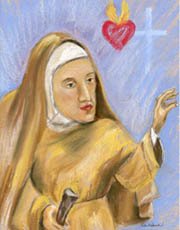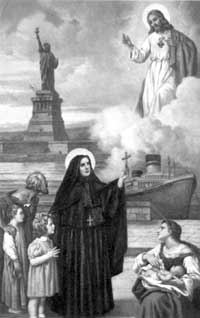
In these days where self sacrifice is almost a forgotten word, where suffering has become an inconvenience for many, and where life itself can be extinguished on a whim, stands one woman who had the courage of a lion, a heart as deep as the ocean and a Faith as great as the highest mountain.
And through this one life, we witness what true love is all about. Life is not about gaining at any price but in giving , life is to be savoured with a true spirit of joy and not spat out as if it measured nothing... life in essence is a gift from God.
Who is this woman who showed the world that self sacrificing love and family matter more than life itself?
Gianna Beretta was born in the year 1922, into a large, loving and devout catholic family, so from a very early age Gianna would have been taught to share all she had with her brothers and sisters. And from her parents, Alberto and Marie's example she was instilled with a deep love for prayer and of the Church, but also of serving others in a spirit of true charity.
But the Beretta family was not without its tragedies, as both Alberto and Marie had to bury 5 of their children at a young age. But it was through the example of her loving parents that forged Gianna to accept all things both good and tragic with a serene heart. And it was also through her parents that she learnt to embrace every facet of life and to live it with joyous exuberance.
Alberto and Marie, would pray the Rosary each evening with their remaining children and this holy and devout couple also attended Mass each morning. Though the Beretta family were not considered wealthy, still they incorporated into their children a work ethic of serving others through their chosen careers.
But a shadow would once again touch the Beretta family with the death of their beloved daughter, Amelia, who had been a tower of strength and also a most loving sister to Gianna. This loss would deepen Gianna's prayer life and her devotion to serving the sick, which was growing in her heart. But the death of her sister also showed Gianna that life was precious and fragile and to embrace every moment as a gift from God.
And so Gianna lived her life with complete and utter confidence in God and a love of nature, for she loved to go hiking in the mountains, bike riding, and skiing. But though sporty and robust she did not neglect her Faith and practiced the corporal works of mercy by becoming a member of Catholic Action.
Through this group she would comfort the afflicted, visit the lonely and infirm and take food to the hungry. Gianna did not do these activities in order to gain praise or merit, Gianna gave because she loved. Her whole spirit imbued a love of Christ and of selfless giving, whilst keeping a joyful and exuberant spirit.
This was a stunning feature in the young Gianna in that though war was ravaging her country and many people suffered terrible persecutions under the leadership of Mussolini, Gianna did not allow these calamitous events to cloud her love of God or doubt God's goodness.
Through her parents loving example she learnt to trust in God alone and to give of herself for love of others. But grief would strike the family again when in 1942 both her parents died within months of each other.
Through the tragedies that struck at her own family, Gianna had a growing vocation to heal others of their afflictions and to give comfort to the sick. She had decided on a career in medicine and through the difficulties of studying in war ravaged country; Gianna persevered through it all and graduated from medical school in 1949.
And though Gianna was a woman of great strength, she was not without faults and failings which she prayerfully tried to overcome. For Gianna had been born with a stubborn streak and a determined nature, therefore she had to practice patience for those who were not as decisive as herself. And in her service to the poor she also could not sit in judgement of those who had chosen the wrong path in their lives.
Upon gaining her Doctorate Gianna decided to specialise in paediatrics, as her love of God instilled in her a reverence for life. But Gianna was not an aloof Doctor and she took a great interest in the lives of her patients and their wellbeing in all facets of life.
Soon her life would be full as she ministered to her patients, continued her recreational activities and also practiced the corporal works of mercy through various Catholic charities including that of the Society of St. Vincent de Paul.
Gianna lived a life of giving to others and helping others to reach their full potential, this was the secret of her joy and love of life. For she encapsulated the prayer of St. Francis, in every aspect of her life as she sought to give hope where there was once despair, light where there was once darkness and comfort to the inconsolable.
But love was to touch Gianna's heart in the form of her future husband Pietro, who had been impressed with Gianna's inner happiness and exuberance as well as her sensitivity towards others. Pietro was drawn to this strong woman, who also displayed a more vulnerable and delicate touch to those in need of compassion. Upon meeting Gianna he could not forget her, as his heart stirred with love for this lovely and generous young woman.
The young couple were married in 1955 by Gianna's brother Fr. Giuseppe, it was a joyous occasion, as this loving couple embarked on their life together. Both looked forward to many happy years together as they travelled around Europe and hoped to have many children.
Pietro and Gianna did not have to wait long before their first born made his entrance into the world, a robust and healthy son who they named Pierluigi. Soon their followed a sister for Pierluigi, who was born in 1957 and named Maria Zita. And in 1959 once again Pietro and Gianna welcomed another daughter into their loving arms, who they named Laura.
As always Gianna proved to be a selfless Mother, who always placed her family over and above her own needs. And she was also a very understanding wife who knew of her husbands longing for moments of solitude away from their family. But as in any family both Pietro and Gianna had their own struggles as they juggled family, careers and interests and also their moments of seperation through work commitments.
Many were amazed at Gianna's energy and zest for life, as she managed her job, her home and the raising of their beloved children. For from a very young age Gianna tried her best to instill in her children what she had learnt from her own parents a love of Jesus and the Church. She also followed in her fathers footsteps and tried to pray the Rosary each evening with her little ones, as well as reading them stories from the Bible and of the Saints.
Gianna Beretta Molla was a living dynamo who gave every inch of herself to those who needed her, for she recognised that to truly love God one must then serve the poor. This was a woman inflamed with a love of God and His creation which radiated her whole persona, and which touched the hearts of all those who met her.
So it was that in 1961 Gianna shared more joyous news with her husband Pietro, as she told him that she was once again pregnant with their child. But this pregnancy was to be different from the others, for Gianna also found out that she had fibroma growth (ovarian cyst) in her uterus. This was worrying for both parents as they grappled with what to do and the decisions that needed to be made.
But through it all as Gianna coped with work, raising her children, being a good wife to Pietro, still at the core of her being was her Christ centred prayer life. Upon the doctors recommendation Gianna and Pietro decided to have as much of the growth removed as was possible without harming their baby.
When the baby was about to be delivered Gianna's informed her doctor that her baby must come first and that she must come last, for no matter the cost Gianna would pay it with her life. Pietro and Gianna welcomed in their new baby on April 21st 1962, she was baptized Gianna Emanuela.
Upon the birth of their much longed for daughter, Gianna's conditioned worsened as she became desperately ill. But throughout her pain and anguish which was great, Gianna's Faith shone through as she enjoined her suffering with that of Christ.
Throughout Gianna's entire life, she lived to give for her sole intent was not to gain but to give and give and give again. The testament to this woman’s life was not that she died so tragically but that she lived life to its full and in the end she died so love could live....
Gianna Beretta Molla died in 1962.
Saint Gianna Beretta Molla was canonized in 2004 by Pope John Paul II.
Some Quotes
"Do not be afraid to defend the honor of God, to defend the Church, the Pope and priests. This is the moment to act. We must not remain indifferent in the face of the enemy’s campaign against religion and morals. We of Catholic Action must be the first to defend the sound foundation and the sacred Christian tradition of our homeland.,,,,,Would you be willing to give your lives for Christ the King? You Who say ‘no’ to your eyes, to your gluttony, you who find the difficulty to help around the house or to pray for a few minutes…?"
Everyone works in the service of man. We doctors work directly on man himself... The great mystery of man is Jesus: 'He who visits a sick person, helps me,' Jesus said... Just as the priest can touch Jesus, so do we touch Jesus in the bodies of our patients... We have opportunities to do good that the priest doesn't have. Our mission is not finished when medicines are no longer of use. We must bring the soul to God; our word has some authority... Catholic doctors are so necessary!"
"With God’s help and blessing we will do our best to make our new family a little Cenacle where Jesus reigns over all our affections, desires, and actions… There are only a few days to go and I feel moved at the thought of approaching and receiving the "Sacrament of Love". We will become collaborators with God in His creation and so we will be able to give him children that love and serve him".
Peace of Christ to you all
Copyright © 2005 Marie Smith. All rights reserved.




